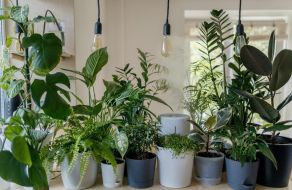Indoor growing has exploded in popularity over the past few years. Even before the lockdowns, people were turning to products that helped them grow plants and gardens in their homes. Some did it for the look and feel of plants in their space. Others did it to grow their own herbs and produce to use in their cooking. Still others wanted a challenge.
In every situation, indoor growing helps people have a fun and rewarding hobby that connects them to the world around them. Comparing the most common types of indoor gardening and growing techniques can help individuals to decide which one is best for them.
1) Gardening Rooms
Think of gardening rooms as the original type of modern indoor growing. With this approach, an entire room is dedicated to gardening. Specialized pots, plants, and climate control technology are all used to make an ideal space. Gardening rooms can offer a high yield of produce, which is what they’re used for primarily. They are also the most demanding. They require the most amount of skill and dedication and arguably are the most expensive.
2) Vertical Gardens
Vertical gardens are, in many ways, new and improved gardening rooms. They take everything about the rooms and puts them into a handy cabinet so things can grow in less space. Vertical gardens started off as essentially shelves for plants. Today, however, they are completely enclosed systems that can automate much of the gardening work. In fact, many of today’s vertical gardens can even come with seed subscriptions so you can continually grow fresh produce with minimal effort.
3) Terrariums
Terrariums are halfway between a gardening room and a vertical garden. They are an enclosed system like a vertical garden but are larger and designed for produce and mini-ecosystems. Some people use terrariums to grow indoor desert gardens. Others use them to grow specific plants for a regular harvest. Because they are enclosed and easy to manage, they are great for people who know what plants they want but don’t want to dedicate an entire room to grow them.
4) Herb Gardens
Many people grow herbs on a little pot or planter shelf on sunny windowsills. So many herbs are easy to care for and have a regular yield. Little herb gardens are handy for everyday cooking. These are perfect for people who want something functional to grow but don’t want to become gardening experts.
5) Air Plant Gardens
Plants like orchids and decorative tillandsia don’t get their nutrients from the soil. Instead, their roots gather what they need from the air. While these plants require regular attention, they can be surprisingly easy to grow and keep alive, especially if you live in a climate that’s amenable to their needs.
6) Living Walls
A living wall is a big statement piece of the indoor growing world. These essentially take a blank wall in your home or office and transform it into a wall of living plants. There are lots of plants that will happily grow up a wall, including pothos, philodendron, and other climbing and winding plants. These will often take a lot of attention and care to keep them happy, healthy, and looking their best.
Which Type of Indoor Growing is Best?
When it comes to picking the right type of indoor gardening, it depends on the commitment, the space, and the goals of each gardener. Those who are looking to grow a lot of usable products should try a dedicated gardening room or vertical garden for the best results. Depending on the gardener’s commitment and gardening skill level, a vertical garden with modern automated features will be best.
For those who are looking for something more low-key but still usable, then a small herb garden in the kitchen can liven up the space and the meals. Finally, for individuals who love indoor plants and want their home to feel like an oasis, then a living wall or air plant garden can be a dynamic and unique statement.
There’s no right answer to which type of indoor growing is best. From the convenience and yield of an automated vertical garden to the challenge and beauty of a living wall, each brings benefits that people love. The challenge is finding the situation that’s right for each person and each space.

Leave a Reply